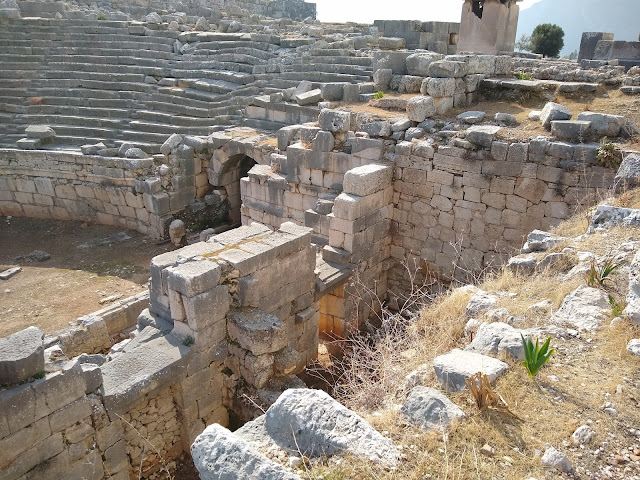 | |||||||
| Roman Amphitheater | | |
Another casualty of our absence was our batteries. About a week before we arrived, David the fellow who was watching Talaria told us that our energy monitor was not working. Well we found out why... the batteries were completely shot and would no longer hold a charge. So batteries were the second item on our repair/replace list. Since we decided to go with AGM batteries instead of lead acid batteries we had to replace our starter battery as well as the house bank. Its not good to mix battery types as the charging requirements are different for different types of batteries - so starter battery and house bank should all be the same type of battery. Since we had to go to the neighboring town to look for a starter battery we decided to make a day of it and do some sightseeing with our "Covid bubble" friends.
 |
| Ruins of Xanthos |
David thought the neighboring town of Gӧcek would be the best place to look for a starter battery. Turns out he was correct as we managed to find the right starter battery there. On the way back from Göcek we stopped to visit the ruins of Xanthos. Xanthos was the capital city of ancient Lycia and the ruins are now a UNESCO World Heritage site. The site represents several different cultures as after the Lycians, Xanthos was occupied by the Persians, Greeks and Romans. The area did not become Turkish until after the fall of the Byzantine Empire in the 15th century.
 |
| Pillar Tomb |
Lycia is known for their architecture and their unique tombs. Lycians built hundreds of rock tombs carved out of the mountain. There are over one thousand rock tombs that dot the landscape of what was once Lycia. Pillar tombs are also found in the region as well as sarcophagi. Sarcophagi are not unique to Lycia, but the Lycian sarcophagi are unique in both size and structure. They are known to be larger than most sarcophagi and built up on pillars. The Lycian sarcophagi are also uniquely embellished with carvings.
 |
| Sarcophagus |
At the entrance to Xanthos there is a plaque describing the fate of the inhabitants when they were conquered by the Persians. The small Lycian army met the Persians in an area north of the city but seeing that they were outnumbered they retreated. Returning to Xanthos they then destroyed their own city and proceeded to kill their wives, children and slaves. Knowing they were outnumbered they then set out to "attack" the Persians certain that they would all die in the attack. The entire population of Xanthos perished that day minus a few families that happened to be away at the time.
 |
| Roman amphitheater |
The Persians held Xanthos for awhile but eventually they too were ousted. Xanthos was conquered by Alexander the Great and later still by Brutus. After Brutus, Xanthos was restored by Marc Antony. So... quite a legacy.
 |
| Xanthos |
The area is so vast which I suppose should not be surprising as it was the capital city. It is remarkable how much remains although the most important pieces were carted off by the British long ago and are now museum pieces. Would be nice to see the temples and tombs where they originated but I am sure it is easier to preserve them in a museum. There is a "sister" site to Xanthos called Letoon which was the "sanctuary". We are hoping to visit there soon so stay tuned!
No comments:
Post a Comment